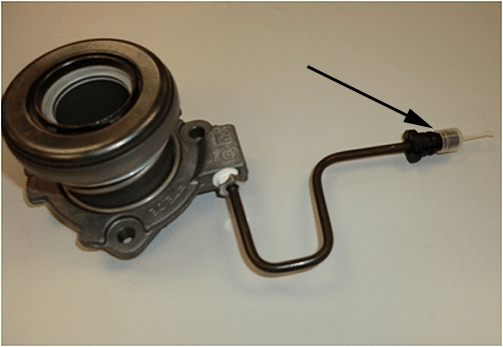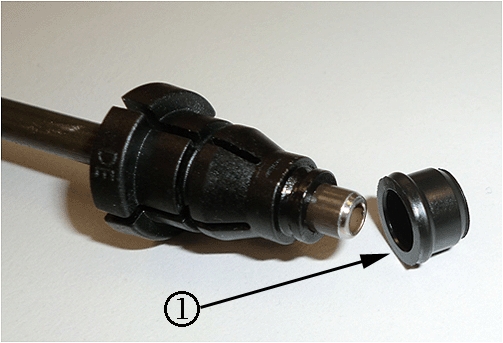| “This site contains affiliate links for which OEMDTC may be compensated” |
NHTSA ID Number: 10113594
Manufacturer Communication Number: PI0421D
Summary
This preliminary informational bulletin provides repair information to correct a customer concern of a fluid leak from under the front of the vehicle, the clutch pedal is hard to push, returns slow, does not return all the way to the top or does not return at all.
9 Affected Products
Vehicles
SEOCONTENT-START
Bulletin No.: PI0421D
Date: Apr-2015
| Subject: | Fluid Leak after Clutch Actuator Replacement |
| Models: | 2011-2015 Chevrolet Cruze |
| 2012-2015 Chevrolet Sonic | |
| Equipped with Manual Transmission |
This PI has been revised to update the Model Years and Warranty Information. Please discard PI0421C.
Condition/Concern


Some customers may comment on a fluid leak from under the front of the vehicle, the clutch pedal is hard to push, returns slow, does not return all the way to the top or does not return at all.
Technicians may also notice the clutch pedal is hard to bleed or clutch slave cylinder seal fails after 3-4 clutch pedal pumps and a fluid leak is observed from the clutch actuator cylinder pipe elbow after the clutch actuator cylinder replacement. The condition may be present as soon as the repair is completed or may surface within 1,600 km (1,000 mi) of repair. The vehicle may also have a repeat clutch performance concern such as slip or high shift effort and clash.
Further inspection may reveal that the leak is brake fluid coming from the clutch actuator cylinder pipe elbow.
After replacement of the clutch actuator cylinder, the seal from the clutch actuator cylinder pipe may be retained in the pipe elbow. The new clutch actuator cylinder has a new seal attached to the pipe and if the old seal is not removed, it can cause a poor seal allowing fluid to leak. It can also cause a blockage in the pipe restricting flow into or out of the clutch actuator cylinder. If the seal is in the right position, fluid will enter the clutch actuator cylinder but does not exhaust and after 3-4 clutch cycles, the cylinder over strokes and the seal fails. The seal can also block the line where the clutch cylinder will not stroke and the pedal will feel hard.
Recommendation/Instructions
Remove the old seal from the clutch actuator cylinder elbow pipe following the procedure below.

- Raise the vehicle.
- Disconnect the clutch actuator cylinder elbow pipe and remove the old seal (1).
- Connect the clutch actuator cylinder elbow pipe. Make sure there is only one seal in place.
- Lower the vehicle.
Warranty Information
For vehicles repaired under the Bumper-to-Bumper coverage (Canada Base Warranty coverage), use the following labor operation. Reference the Applicable Warranties section of Investigate Vehicle History (IVH) for coverage information.
| Labor Operation |
Description | Labor Time |
| 8480248* | Remove Clutch Actuator Cylinder Elbow Seal | 0.3 hr |
| *This is a unique Labor Operation for Bulletin use only. It will not be published in the Labor Time Guide. | ||
SEOCONTENT-END
Bulletin No.: PI0421D
Date: Apr-2015
To View or Download this Document Click Here
 Loading...
Loading...
Bulletin No.: PI0421C
Date: Nov-2012
To View or Download this Document Click Here
 Loading...
Loading...
Bulletin No.: PI0421C
Date: Nov-2012
To View or Download this Document Click Here
 Loading...
Loading...
Bulletin No.: PI0421C
Date: Nov-2012
To View or Download this Document Click Here
 Loading...
Loading...
NHTSA ID Number: 10098702
Manufacturer Communication Number: PI0421C
Bulletin No.: PI0421C
Date: December, 2012
To View or Download this Document Click Here
 Loading...
Loading...
| “This site contains affiliate links for which OEMDTC may be compensated” |
- Provides an extra margin of safety in extreme braking conditions
- Mix of polyglycol ethers ensures hot brake-system operation will not create dangerous vapor
- Excellent for ABS, disc and drum brake systems
- Delivers braking power when needed by avoiding a spongy pedal
- Both wet and dry boiling points exceed the minimum government standards
- High compatibility. Use with or direct replacement for DOT 3, DOT 4, and DOT 5. 1
- Extended Service Interval (ESI): Lasts 100 percent longer than DOT 3, 50 percent longer than DOT 4, and 10 percent longer than DOT 5. 1
- Exceeds all DOT 3, DOT 4, and DOT 5. 1 standards
- Wet boiling point ~ 365 DegreeF/Viscosity at -40 DegreeC ~ 685mm2/s
- Standard brake fluid has a recommended change interval of 2 years. The recommended change interval for Bosch ESI6 is 3 years.
- Premium brake and hydraulic clutch fluid that protects internal components from corrosion under normal use
- High boiling point to minimize brake fluid boiling and vapor lock
- Excellent low temperature capability and stability when used where lower cold viscosities are required
- Excellent low temperature capability and stability when used where lower cold viscosities are required
- DOT 3 Brake Fluid/12x1/12 Ounce
- DOT 3 Brake Fluid/12x1/12 Ounce
- DOT 3 Brake Fluid/12x1/12 Ounce
- DOT 3 Brake Fluid/12x1/12 Ounce
- DOT 3 Brake Fluid/12x1/12 Ounce
Last update on 2025-05-08 / Affiliate links / Images from Amazon Product Advertising API
This product presentation was made with AAWP plugin.











I am also having the same issue now, 4 release bearing changed .what to do.
What if its still leaking brake fluid after all this and its been Repeated on 3 different slaves?? Every time its put back together an gets some pressure built up the seal.blows an it starts pouring brake fluid from the bottom of the trans. My car has been down almost 2 months because of this problem an 2 shops told me they can’t figure it out. I’ve dome replaced the whole clutch an bought 2 other slaves after I bought the clutch kit. Someone please help Me out.
im currently having same issue please let me know if you figure it out
bryan s
I replaced new clutch and when taking air bearing get leaked some one help me.this is 3rd bearing
pls u find the problems